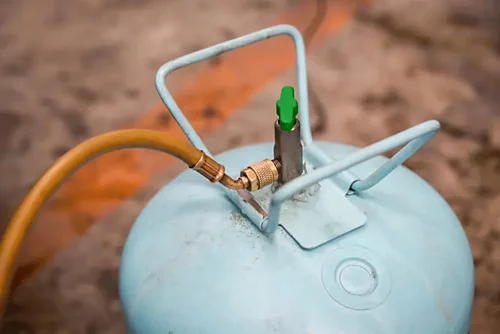Concerns about Flammability:
The flammability of R32 is one of its biggest drawbacks. R32 is categorised as an A2L refrigerant, which means that it is mildly flammable but has minimal toxicity. Its tendency to burn under specific situations raises safety concerns even though it is not as flammable as other refrigerants in higher flammability categories.
- Impact on Installation: To prevent any sources of ignition, extra care must be taken during installation and maintenance. This makes handling the refrigerant more difficult and expensive.
- Restricted Use in Certain Applications: The use of R32 may be restricted in some areas or industries due to its flammability, particularly in large-scale systems or places with rigorous safety regulations.
Problems with Compatibility:
Not all of the current air conditioning and refrigeration systems are compatible with R32. Compared to previous refrigerants like R22, it runs at a higher pressure, which can provide difficulties in updating or retrofitting systems.
- Requirements for System Design: Air conditioners made for R32 must be constructed to withstand its unique pressure and thermodynamic characteristics. It is frequently not possible to retrofit older systems.
- Compatibility of Materials: Compressors, hoses, and seals might need to be specially made for R32, which raises the cost of production.
Increased Operating Pressure:
Compared to certain conventional refrigerants, like R22, R32 functions at a higher pressure. This may lead to several problems:
- Component Strain: Compressors and pipes are among the system components that are subjected to increased strain due to the increased pressure, which could shorten their lifespan if improperly constructed.
- Leak Risk: Because of the increased pressure, there is a greater chance that minor leaks will develop into larger problems, so systems must be well sealed to prevent leaks.
Limited Awareness and Training:
Even though R32 has been becoming more popular in the HVAC sector, professionals and installers still need to become used to it.
- Specialised Training Required: Because of its flammability and operating pressure, handling R32 calls for specialised training. Training expenses rise because technicians must know how to use the refrigerant properly.
- Insufficient Expertise: In certain areas, a lack of general training and experience may lead to incorrect installations, which could compromise safety or cause inefficiencies.
Restrictions on the Environment:
Despite having a significantly lower GWP (675) than R410A (2088), R32 is still not an ideal environmentally friendly alternative.
- Not Carbon Neutral: Although it is less harmful to the environment than earlier refrigerants, it nevertheless has a role in global warming. R32’s shortcomings are brought to light by the need for increasingly greener refrigerants, including natural refrigerants (like CO2 or ammonia).
- Possible Tighter Regulations: R32 may be subject to more stringent regulations as global environmental standards change, which would force the HVAC sector to switch to refrigerants with even lower GWPs.
Exorbitant Upfront Expenses:
Higher upfront expenditures are frequently associated with R32 adoption for both manufacturers and end users.
- Cost of New Equipment: Because R32 requires specific materials and designs, air conditioning systems built for this system are usually more costly.
- Costs of Servicing: Compared to more known refrigerants, maintaining R32-based systems can be more expensive due to the need for specialised equipment and knowledge.
High Concentration Potential Toxicity:
Despite being categorised as a low-toxicity refrigerant (A2L), large amounts of R32 can be dangerous.
- Risk of Asphyxiation: The possibility of asphyxiation arises from the possibility that R32 may displace oxygen in an enclosed environment in the event of a substantial leak.
- Combustion Byproducts:In the unlikely event that an R32 fire breaks out, dangerous byproducts like hydrofluoric acid (HF) could be discharged, raising further safety issues.
Restricted Access:
Compared to more well-known refrigerants, R32 is still not widely available in some areas.
- Supply Chain Difficulties: R32’s supply chain could not be as reliable as that of older refrigerants due to its relatively recent use, which could cause delays or increased expenses.
- Reliance on Manufacturers: The range of R32-compatible equipment may be somewhat limited because many air conditioning manufacturers are currently making the switch.
Difficulties with Retrofitting:
Retrofitting can be challenging for companies or people wishing to switch from older refrigerants like R22 or R410A to R32.
- Incompatibility with Older Systems: R32 is incompatible with earlier systems, which means that a complete system upgrade is frequently necessary because it cannot be used as a direct substitute for older refrigerants.
- Extra Expenses: Making the switch to an R32-compatible system requires a large monetary investment for new hardware, installation, and training.
Misconceptions and Public Perception:
Because R32 was only recently introduced in various markets, there are misunderstandings among the general public regarding its effectiveness and safety.
- Fear of Flammability: Even when the hazards are well controlled, many consumers are hesitant to use a refrigerant that is only slightly flammable.
- Absence of Knowledge: Lack of knowledge about the advantages and disadvantages of R32 may cause businesses and consumers to oppose it.
Final Thoughts:
Refrigerant R32 has drawbacks even if it has several significant advantages over older refrigerants, such as increased energy efficiency and a smaller environmental effect. Among the difficulties with R32 include flammability issues, compatibility problems, increased operating pressures, and the requirement for specific training. Adoption of this refrigerant is further complicated by public misconceptions, high initial costs, and environmental restrictions.
Frequently Asked Questions:
1. What Makes Synthetic Oils Necessary For Certain Refrigerants?
For appropriate lubrication, some refrigerants, such as R-410A and R-32, require synthetic lubricants, such as polyester or POE oils. These oils provide seamless system functioning and are compatible with the chemical makeup of contemporary refrigerants.
2. Is It Possible To Replace An Older Air Conditioning System With New Refrigerants?
Although it’s not always economical, retrofitting is feasible. To guarantee compatibility with new refrigerants, parts including compressors, expansion valves, and lubricants must be replaced. Often, switching to a new, effective system is more sensible.


